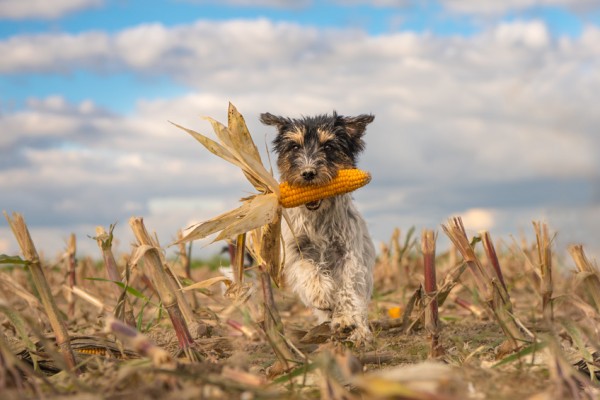In dog nutrition there are three major energy suppliers - proteins, fats & carbohydrates. These provide important nutrients and provide the necessary energy supply. In this article, we want to specifically address the use of carbohydrate-rich feeds in home-prepared dog feeding. This is because partial BARFing or cooking for the dog is increasing in popularity.
In a classic BARF ration, feeds with high carbohydrate content are not used. In this case, a ration consists of meat, offal, vegetables, special types of oil and a suitable mineral powder or individual supplements. This is also perfectly fine, as there is no specific need for carbohydrates. A cooked or partial BARF ration, on the other hand, is typically supplemented with cooked carbohydrate-rich components. This saves on meat and lowers the protein and phosphorus content.
In certain cases it is necessary to reduce the supply of meat and consequently of protein and phosphorus for the sake of health. So that the dog in this case does not have to take up the calories missing by the meat reduction over usually incompatible high fat quantities, soft cooked carbohydrate-rich feed e.g. potatoes or noodles provide the necessary energy balance. Cooking breaks down the starch contained in the food, making it an easily digestible source of energy. Animals that can hardly tolerate fat also benefit from the use of cooked carbohydrates, as these themselves contain hardly any fat, but at the same time provide energy.
Even in healthy animals, the use of carbohydrates can be useful - irrespective of the meat-saving aspect already mentioned. This applies, for example, to dogs with a very high energy requirement. For them, the use of cooked carbohydrates in home-prepared feeding is recommended so that the calorie requirement does not have to be covered by extremely high amounts of protein and fat. The self-prepared feed for pregnant bitches should also contain carbohydrates since the still unborn puppies cover their energy requirements mainly through glucose. This is obtained in the dog's body by enzymatic breakdown of ingested starch.
Systematics of carbohydrates
Depending on their chain length, carbohydrates are subdivided into monosaccharides, disaccharides, trisaccharides, oligosaccarides and polysaccharides. Monosaccharides include glucose (also known as dextrose) and fructose. Typical representatives of the disaccharides are the classic household or crystal sugar (sucrose), milk sugar (lactose) and malt sugar (maltose). If carbohydrates consist of a chain of three to ten molecules, they are called oligosaccharides (e.g. stachyose, raffinose). If there are ten or more molecules, they are called polysaccharides. These include starch, cellulose and glycogen.
Feed with high carbohydrate content
Feedstuffs rich in carbohydrates, which are used in homemade dog feeding, contain mainly starch to a high degree as digestible carbohydrates. If this is broken down by appropriate heating, it represents an important, quickly and easily available source of energy for the dog. They cannot be used uncooked (with the exception of oatmeal).
The classics of starch-rich feeds include potatoes, pasta and rice. However, there are many other varieties such as sweet potatoes, millet, amaranth, quinoa and oatmeal that can be used.
However, many pet owners have concerns about using grains or the protein they contain, gluten. Allergies to the grain protein gluten in general, however, are rare in our four-legged friends. If symptoms such as abdominal pain and flatulence are observed, in most cases these are not the result of intolerance, but often arise from the lack of habituation of the gastrointestinal tract to these starch-rich foods.
If a dog receives little or no carbohydrates, the activity of its starch-cleaving enzymes is usually low. If the dog suddenly gets a portion of noodles left over from the meal, for example, there is usually a change in the consistency of the feces, since the enzymes present in the small intestine are not sufficient to digest the starch, and it thus enters the large intestine. In the large intestine, it is then broken down by the intestinal bacteria located there, and soft feces and flatulence can be the result.
However, enzyme activity can adjust according to the amount of starch in the daily feed. However, since this takes a few days, it is very important to slowly incorporate starchy foods into the dog's ration and carefully increase the amount over a few days. It is also important to cook the starchy components "mushy" (except oatmeal), i.e. 10-20 minutes longer than usual for humans. Thus, the starch is sufficiently broken down and can be well digested by the dog. Oat flakes, on the other hand, can be fed without cooking. For them, however, the slow increase in the amount fed also applies.
Another possibility is also the use of "flakes". In these, the starch has already been industrially broken down by heat and pressure, so they only need to swell in hot water before feeding. This simplifies the preparation significantly. However, dogs may not tolerate these flake products as well as home-cooked carbohydrates. In this case, you can try to properly boil the flakes in water and puree them. Flakes also need to be slowly increased in quantity and should not be given directly in large quantities.
If you, as an owner, would like to avoid gluten or grains when feeding carbohydrates, this listing should help you with your selection:
gluten-free: potatoes, rice, corn, millet, quinoa, amaranth contain gluten: wheat, spelt, rye, oats, green spelt
grains: rice, wheat, spelt, rye, oats, green spelt, millet, corn pseudograins: amaranth, quinoa
image credits:

